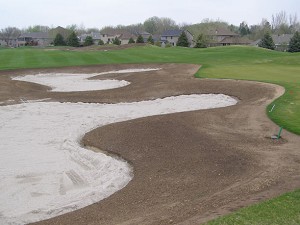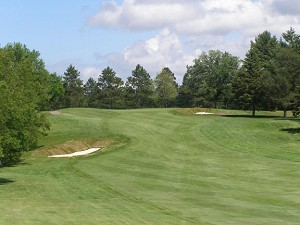From The Architect’s Desk – Renovating A Golf Course
By Kevin Norby
As golf course architects, there are many issues that we need to consider when deciding how or why to renovate a golf course. Most often, when I get a call from an owner or a golf course manager, they are usually looking to make changes that they hope will increase the popularity of their course and lead to increased membership or improved revenue. When I get the call from the golf course superintendent, it’s often because they are looking for ways to improve course conditioning and turf quality or because they are simply looking for advice on how to fix a particular problem. We do a lot of what we call “long range master planning” for golf courses. The process involves identifying existing or upcoming issues and then providing recommendations on how to resolve those issues. Essentially, we’re creating a roadmap for what we want the golf course to look like in 10 years and then helping to prioritize those improvements. So, what goes into renovating a golf course?
Public or Private
One of the first questions I always ask is “who is your primary customer and who is your competition”? It doesn’t matter whether you are selling shoes, cars or golf; the business owner needs to know who their customer is. Once we understand who the target customer is, that tells us how to design the golf course. The way we design a public golf course is often quite different than the way we design a private golf course. The National Golf Foundation tells us that the “average golfer” is someone who plays 4 times a year and scores 110 for 18 holes. So, there are a whole lot of people out there that play golf but who don’t think of themselves as golfers and a lot of people don’t even keep score. They simply play for the fun of it. They’re really out there for the social part of the game and they don’t really care about the challenge or the strategy of the game. So, when we design a public golf course, we often have fewer bunkers or hazards, wider fairways and we try to avoid forced carries over water.
At private clubs, the average golfer is a bit more skilled and might play anywhere from twenty to a hundred and twenty rounds in a year. They tend to work on their game more and are often looking for a bit more challenge and strategy. Private clubs tend to have larger maintenance budgets, the greens tend to be faster and their expectation is often that the course conditioning will be exceptional. Therefore, when we are working at a private club, we try to incorporate subtle breaks in the greens, the bunkers may be deeper and more dramatic and each hole should have some strategic advantage that requires the golfer to figure out the best route to the cup. We also know that the majority of members at a private club prefer to walk rather than take a cart so we need to think about how the sequence of holes or the distance between holes will affect pace of play.
Greens and Bunkers
We start by routing the hole to provide safe fairway corridors with good sight lines to the landing areas and green. We then determine the strategy of the hole by adjusting the placement of hazards, the angles of approach and the size of the green. The largest greens on a golf course are usually the par threes and the long par fours. The par three greens take the most abuse from ball marks and therefore need to be a little larger. Because they are a little larger, they can have a little more slope as long as there are still enough cupable areas. On the long par fours, we try to provide a little bigger target so golfers have the opportunity to get home in two. However, we might incorporate some kind of runoff area or a ridge through the green to require the better golfer to play to a specific area of the green in order to have a chance at birdie. The smallest greens are usually the short par fours and the short par fives. Here, we want to create a smaller target that challenges the long hitter who might try to reach a drivable par 4 or get to the green in two on a par five while, at the same time, not really affecting the short hitter or beginning golfer.
We use bunkers to visually frame the hole, define the landing areas and to create strategy. Around the green, we use bunkers to guard the green and to create preferred angles of approach. Generally, greenside bunkers can be a little smaller, a little deeper and a little more dramatic than fairway bunkers. How far we place the bunker from the putting surface is dependent in part upon the length of the hole, the size of the green and how difficult we want the hole to play. In my opinion, it is critical that bunkers be visible. We want the golfer to be able to see the entire hole and the hazards when preparing to hit his shot so that he can make a decision on how to play the hole. For that reason, I don’t generally put bunkers on the backside of a hill or behind a green where they can’t be seen. However, there are times where we might propose a “savior bunker” or grass hollow behind a green to gather a shot that might otherwise trickle off the green into water. We did this behind No. 10 at Greystone. If you miss the green long, you’ll probably think you went in the water but when you get there, chances are you’ll find the ball is safe and playable.
Public golf courses usually have smaller budgets and more limited resources than private clubs so we need to consider maintenance when renovating a golf course. If the course is a public golf course, the bunkers may be somewhat smaller and easier to maintain. Flatter sand and softer less-rounded capes and grass faces can be maintained with more traditional rough mowers whereas steeper faces and more rounded capes may require mowing by hand or specialized equipment. If the course is private or a higher-end destination course with a more substantial maintenance budget, we might not only incorporate more bunkers but they may be larger and more dramatic. At Prairie Green Golf Course in Sioux Falls, we created large dramatic bunkers with big grass capes and large bays of sand. If the budget allows, we might incorporate a premium white sand such as those available from Ohio or Arkansas.
Modern or Classic (or something in between)
In my June article I discussed the difference between modern golf courses and classic golf courses. Both styles of courses have a unique look that is largely a function of when and how the course was constructed. Courses built around the turn-of-the-century were built using horses and carts or smaller mechanized equipment whereas modern courses built from the 1940s to present day were built with large gas powered bulldozers and earthmoving equipment. When doing a renovation, it’s important to try to understand when the course was built and, if possible, who the original architect was. On older classic courses, we often try to enhance or restore of the original character of the course. Over time, bunkers get filled in and the unique details that might have made the course interesting get lost. I am currently working on a renovation at Bemidji Town and Country Club in Bemidji, Minnesota. When I first visited the course, the club told me that they thought the course was built in the 1920s but didn’t know the exact date or the name of the architect. I checked with the local historical society and found some old documents and newspaper clippings that indicated that the course was actually built in 1919. We still don’t know the name of the original architect but we’re now working to remodel the course in a style, which would be reminiscent of classic golden-age architecture. We’re removing trees to restore the original fairway corridors and we’re making the bunkers much smaller and deeper to accentuate the classic greenside fall-offs.
Golf Course Maintenance
Maybe one of the best reasons to renovate is to reduce the amount of time and money spent on unnecessary repairs and maintenance. Eliminating bunkers that wash out or converting turf to low maintenance areas are obvious areas for improvement. This isn’t so much an issue of reducing maintenance costs but rather reducing the need for unnecessary repairs so that the maintenance staff can focus on the more important tasks that impact turf quality and playing conditions.
One of the biggest issues I see on a regular basis is the problem that trees can cause when the wrong tree is selected or when trees are placed in the wrong location. In my last article I talked about how golf courses can be good for the environment. They aid in reducing runoff and pollutants and they provide habitat for birds and animals. Unfortunately, I visit a lot courses that, over the years, have planted too many fast growing trees like green ash, poplar, cottonwood and spruce. These fast growing species are relatively short lived, messy and prone to storm and disease damage. In order to increase diversity and minimize problems, golf courses should be removing weak and damaged trees and planting a variety of more-desirable and longer-lived trees like Hackberry, Linden, Maple, Elm and Pine.
Also, one of the most problematic and overused trees on golf courses is the spruce tree. These trees have very shallow root systems which, combined with the dense shade, make them almost impossible to grow grass under. Unfortunately, a lot of well-intended committee or Board members seem to like to plant spruce in rows between holes or in dense groupings only to later have them limbed up into Dr. Seuss-looking trees so they can hit their ball out from under them. Pines on the other hand are quite easy to grow grass under and they look perfectly natural as they mature and get limbed up.
The removal of trees is often the one of the most contentious and controversial issues I encounter. In Colorado we’re working with club that forty years ago planted some 800 spruce trees and now those trees are jeopardizing the health of the golf course. Many have been damaged from ice storms and nearly all of them are nearing the end of their life span. Nobody likes to cut a perfectly healthy tree down but, as golf architects, we try to help golf course owners balance the long-term benefits of diversity and turf quality with short-term politics of public appeasement.
I feel pretty lucky to be doing what I do for a living – most of the time it hardly feels like work. It’s fun to visit courses I’ve never been to and, every once in a while, come across a new hidden gem that I never knew existed. If I could play even half of the courses I visit my handicap might actually be where I’d like it to be.

As golf course architects, there are many issues that we need to consider when deciding how or why to renovate a golf course. Most often, when I get a call from an owner or a golf course manager, they are usually looking to make changes that they hope will increase the popularity of their course and lead to increased membership or improved revenue.



